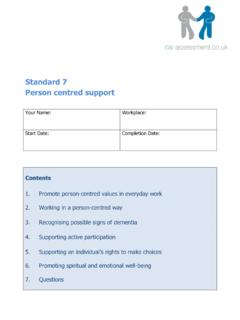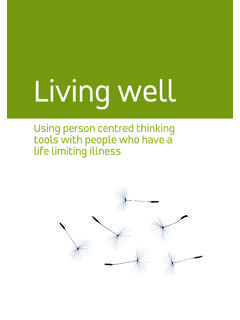Transcription of Language Matters - england.nhs.uk
1 Language Matters Language and diabetes2 With Great Diabetes care continues to evolve at pace with modern technology, insulin and dietary modifications in exciting stages of evolution and , as healthcare professionals, it is also imperative to remember that we perhaps don t live the lives of those living with diabetes - and thus need to be aware of the impact our words may have on their diabetes care . For the brief moment we see them, our approach needs to be collaborative and inclusive, not judgemental; as words (verbal or non-verbal) can have an impact far reaching than one can comprehend, especially in the setting of a long term condition.
2 To be perfectly honest, it is up to the person concerned as to how they would like to be addressed, supported and understood but as healthcare professionals, we need to be aware of the need to give them that choice, not make it for view of this, NHS England have worked with a range of diverse individuals living with diabetes as well as all relevant stakeholders to develop this piece of work - which hopefully will act as a guide to all healthcare professionals interacting with people living with word of thanks to Professor Jane Speight and Renza Scibilia for their pioneering work in this arena in Australia and to Jane Dickinson from the USA who have been great inspirations and help in making this idea come true.
3 Importantly, a special thank you to the group that have helped to develop this document; especially Cathy Lloyd and Anthea Wilson for their research; Anne Cooper, Bob Swindells, Rosie Walker, Jen Nash and Sarita Naik for their time and dedication to the project, and to Simon Enright for his support of this care is changing and if we as healthcare professionals want to make a difference, it is the building of relationships and respect which places the patient at the heart of that change which will take it to the next stage.
4 We need to be trusted guides in the journey of those living day in, day out with diabetes. As the saying With great power, comes great responsibility . Hopefully this piece of work goes some way towards realising the importance of that ethos. Dr Partha Kar Associate Clinical Director, Diabetes NHS EnglandForeword3 The Language used by healthcare professionals can have a profound impact on how people living with diabetes, and those who care for them, experience their condition and feel about living with it day-to-day.
5 At its best, good use of Language ; verbal, written and non-verbal (body Language ) which is more inclusive and values based, can lower anxiety, build confidence, educate and help to improve self- care . Conversely, poor communication can be stigmatising, hurtful and undermining of self- care and have a detrimental effect on clinical outcomes. The Language used in the care of those with diabetes has the power to reinforce negative stereotypes, but it also has the power to promote positive with diabetes internalise messages from the media, from those around them, but most of all from their healthcare providers.
6 When these messages are perceived negatively, whether it is intended or not, this can lead to feelings of shame, guilt and resentment. People who are ashamed of a condition will find it much harder to engage and manage that condition this document, the authors and supporting organisations have set out practical examples of Language that will encourage positive interactions with people living with diabetes and subsequently positive outcomes. These examples are based on research and supported by a simple set of principles.
7 The preferences of those living with diabetes as to how they wish to self-identify or be addressed should always be respected, but it is important to remember that the relationship between healthcare providers and those with whom they interact is often not an equal one. It is recommended therefore that all professionals working with the diabetes community, including healthcare professionals, commissioners, educators and those in the media who report on the condition, adopt the principles and practice set out in this Cooper Living with Type 1 DiabetesBob Swindell Living with Type 2 DiabetesIntroductionBeing described as non-compliant is awful and does not reflect the fact that everyone is doing their best, maybe not the same best as someone else.
8 Or even their best best but just the best they can at that moment. Life is way more than Type 1 Diabetes and it isn t always given top priority. Life gets in the with Type 1 Diabetes4 Be aware that Language , both verbal and non-verbal, has enormous power, which can have positive or negative effects. Recognise that some words, phrases and descriptions are potentially problematic, whatever the intention of the user. Use Language (including tone and non-verbal gestures) that is: - free from judgment or negative connotations, particularly trying to avoid the threat of long-term consequences or scolding ( telling off ); is inclusive and values based Language .
9 - person-centred, (also known as person-first ) to avoid labelling a person as their condition. - collaborative and engaging, rather than authoritarian or controlling. Review the use of common expressions and what underlying attitude they may convey, regardless of intention. Avoid Language which attributes responsibility (or blame) to a person for the development of their diabetes or its consequences. Avoid Language that infers generalisations, stereotypes or prejudice, or links one individual with previous experience of others of a similar background or in a similar situation.
10 Use or develop an empathic Language style which seeks to ascertain a person s point of view of their condition, rather than assume. Listen out for a person s own words or phrases about their diabetes and explore or acknowledge the meanings behind them. Become alert to the use of Language , and non-verbal communication body Language and recognise if it may be creating a negative effect. Consider how to limit any negative effects from Language used, both for yourself and with others around hate sufferer too, lives with is better and my child has Type 1 and is not a diabetic , would you introduce another child as a myopic.













